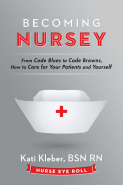 Thinkstock | Fuse
Thinkstock | Fuse
Having assessed the patient assessment skills that she learned in nursing school (super “meta”—right?), Kati Kleber, aka Nurse EyeRoll, decided it was time for a whole new set.
And because she’s such a wonderful human being/nurse, she decided to share some of those tried-and-true assessment basics with her fellow nurses, and now—you:
I had an assessment class in nursing school. It wasn’t anything like what I do in the real world.
Great.
It was way too broad and was vastly different for each specialty that they wanted to make sure we experienced. I’m glad I saw the OR, OB, mental health, the ED, the ICU and various floors, but one thing that I didn’t get out of all of that [was] solid assessment skills.
Here’s how to quickly rock a basic assessment for a med-surg floor patient.
Talk to them.
How are you? Are you in pain? Tell me about what led up to you coming in to the hospital. How was your night?
This normal convo tells you a lot within a neuro assessment…it’ll tell you if they’re alert and oriented, if their speech is clear, if their face is symmetrical when they talk, etc. Walk around their bed, see if they track you appropriately as well. BOOM. Basic neuro assessment. Done.
Shine a pen light in their eye.
Are their pupils equal, do they react briskly and do they accommodate light appropriately?
Take a listen.
Listen to their lungs in six spots on their back, then their heart in two or three spots, then their bowel sounds in all four quadrants. Start listening in the right lower quad, which is where the ileocecal valve is located, and they should be the loudest there.
Ask when their last bowel movement was. If it was within the last 24 hours, ask if it was loose/diarrhea. Most patients are on some sort of stool softener, so this will tell you if you need to hold it or not. However, if they are taking pain meds or are fresh post-op, make sure they get their stool softener!
Press on their abdomen, ask if there is any abdominal pain and note if it is distended or firm.
Grip and feel.
Have them grip your hands and let go on command, then feel their radial pulses.
Dorsi/plantar flexion and feel.
Have them dorsi/plantar flex on your hands and feel their pedal pulses.
If you don’t know where those are, I’m sure your assessment textbook overexplains it somewhere.
Questions to ask:
Are you having any numbness/tingling? (Sensory assessment) If they say yes and are diabetic and have a history of neuropathy and always have numbness/tingling, ask if it is different than normal.
Are you in pain? Please rate it on a scale of 1-10. Don’t forget to tell them that a 10 is burning alive or something.
Do you have any questions about our plan today or anything you want to ask the doctor? Just to make sure you’re on the same page about what’s going on.
Skin assessment.
Okay, I may be a bad nurse for saying this, but if you’re a completely fine patient, I don’t roll you over and look at your butt immediately. When I have those 40-year-olds with a minor surgery, I’ll wait to look at their butt until I walk them to the bathroom and sneak a peek. I don’t roll them over and throw back their gown with four family members staring at me.
However, I do always make sure I sneak in a butt peek at some point during the day. Sometimes halfway through my shift, I think, “Did I see that guy’s butt today?” If not, I go take them to the bathroom and grab a glance. It’s important: You need to see that butt. However, if you have people going crazy when you’re getting report, or you’re doing your first assessment and someone’s having changes that need your attention, the priority of checking out their cheekers has just fallen down to the bottom (ha!) of the list.
If they have any dressing changes, I wait to look and chart until I’m ready to change it. That sucks for their skin if you’re taking tape off multiple times around a sensitive wound. If I’m not ready to change the dressing, I wait to look at the wound. However, use your nursing judgment. If you think it’ll be hours before you can change the dressing, go ahead and peel the dressing back to take a look and replace it. You don’t want it to go all day without someone seeing it! Not that you should wait until the end of the day for your dressing change.
If they’re morbidly obese or a total care patient, I wait until my tech bathes them to look at their backside or until it’s time to turn them. There’s no need to do that right after shift change and again 45 minutes later when you tech does a bath. Cluster your care and manage your time.
Always, always check their butt/coccyx/folds, etc. If it’s a hefty boob situation, I’ll throw a dry washcloth on each side. That’ll keep it dry in there. You must be consistent with your turns with total care and obese patients. If they get a pressure ulcer because you didn’t turn them, it’s a REALLY BIG DEAL. So if I’ve done all my assessments and my tech is nowhere near getting to that bath, I’ll grab them to help me turn the patient and take a good butt peek. (Tip: I’ll use this time to also listen to posterior lung sounds if they’re difficult to roll. Knock out your lung + skin assessment + a turn in less than a minute.)
And good Lord, do not forget to look at their heels. If they’ve been in bed for a while, are total care, [are] morbidly obese, [have] crappy nutritional status, etc., those heels can break down before you know it. I’ll lift those gams when I’m having them dorsi/plantar flex and make sure [they’re] not getting red.
Also, make sure their folds aren’t breaking down or they don’t need any Nystatin powder or anything.
All the while, make sure to note if their skin is dry, flaky, pale, bruised, gross, etc.
Now hurry and chart it before you forget!
To read more, visit NurseEyeRoll.com.
 Becoming Nursey: From Code Blues to Code Browns, How to Take Care of Your Patients and Yourself talks about how to realistically live as a nurse, both at home and at the bedside…with a little humor and some shenanigans along the way. Get ready: It’s about to get real, real nursey. You can get your own copy at NurseEyeRoll.com, Amazon or Goodreads (ebook).
Becoming Nursey: From Code Blues to Code Browns, How to Take Care of Your Patients and Yourself talks about how to realistically live as a nurse, both at home and at the bedside…with a little humor and some shenanigans along the way. Get ready: It’s about to get real, real nursey. You can get your own copy at NurseEyeRoll.com, Amazon or Goodreads (ebook).

















